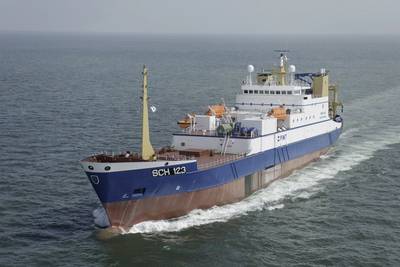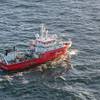Innovative Trawls Help Reduce the Enviromental Impact
Fishing Company Cornelis Vrolijk, based in IJmuiden, The Netherlands, and its subsidiary Jaczon, based in Scheveningen, The Netherlands, are specialized in pelagic fishing. The fishing trawls on board of their trawlers, which are used for catching pelagic (schooling) species, are traditionally made of nylon. Cornelis Vrolijk and Jaczon are now replacing their nylon trawls by trawls made from DSM’s light and exceptionally strong UHMwPE (ultra high molecular weight polyethylene) fiber, branded as Dyneema.
The use of this far thinner material in pelagic trawls offers immediate and tangible environmental advantages. The reduced resistance of the trawls in the water translates into a significant reduction in CO2 emissions, thus reducing the CO2 footprint of the pelagic fishing fleet. In this way Dyneema makes a substantial contribution to improving the overall sustainability of the fishing industry.
The innovative trawls made from Dyneema were developed by Maritiem BV in Katwijk, The Netherlands, in close consultation with DSM. Around 90% of the trawl material is Dyneema. During both the design and use of the trawls, Maritiem worked closely with the relevant departments of both fishing companies and with the officers on board the vessels.
Dyneema fiber is used in hand-spliced front sections of the trawls, from mesh size 800 mm and up. According to Maritiem some of these sections were previously made of knotted netting, but the knots were prone to slip. This does not happen with hand-spliced trawls. Dyneema can be used for these sections. Dyneema is also used for the selvedge lines and the frame ropes.
In order to allow for a proper comparisons, identical trawls made of predominantly conventional materials such as nylon, were also carried on board some of the vessels. This made it possible to compare the performance of the different materials used in trawls of an identical design. The fishing company's assessment of the new trawls was extremely positive.
Eric Roeleveld, Operations Manager of Jaczon said, “As a company specialized in pelagic trawling, we are profoundly aware of the environmental impact of our activities. One of our key drivers is to continuously look for increased sustainability in our fishing methods. We try to reduce our CO2 footprint wherever possible and support the FAO code of conduct for sustainable fisheries.”
Cornelis Vrolijk and Jaczon now have eight of the trawls made with Dyneema in use. The size and shape of the trawls depends on the targeted species, fishing area and the dimensions of the vessel.
The newly developed trawls offer a number of specific benefits in comparison to traditional nylon versions. The lighter material makes them easier to handle and therefore safer in use for the crew.
Feedback on the new fishing trawls has been favorable: “Positive results are coming in from all quarters,” said Johan Müller, Cornelis Vrolijk’s Fishing Fleet Manager, “We can also confirm a substantial reduction in fuel consumption and subsequent CO2 emissions.”
As well as easier, safer use and savings on fuel, the development of lightweight fishing trawls has brought about a major improvement in sustainable fishing techniques. “This is good for the environment and good for the fishing industry,” Müller said. “We would definitely encourage other fishing companies to adopt this strategy and the use of this new material as well.”














